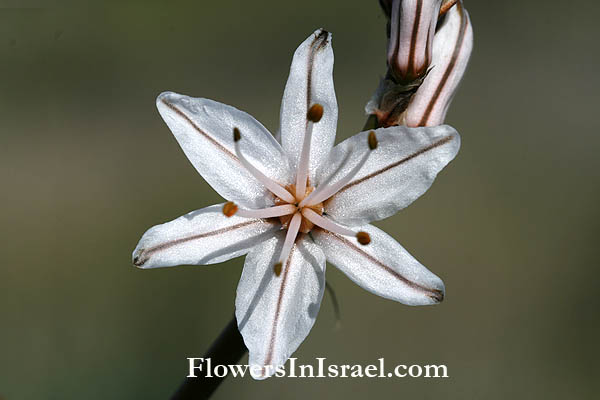Onion-leaved asphodel, Onionweed, Pink asphodel,
Hebrew: עירית נבובה, Arabic: غيصلان
| Scientific name: | Asphodelus fistulosus L. | |
| Common name: | Hollow-stemmed Asphodel, Onion-leaved asphodel , Onionweed, Pink asphodel | |
| Hebrew name: | עירית נבובה | |
| Arabic name: | غيصلان | |
| Family: | Liliaceae, שושניים |

|
| Life form: | Therophyte, annual | |
| Stems: | Erect, smooth, hairless, hollow stem up to 70 centimeters tall; rigid, do not have any leaves, and are usually branched in their upper parts | |
| Leaves: | Tufted leaves, rosette, entire, elongated, smooth, terete, hollow, slightly fleshy, and an onion-like appearance | |
| Flowers: | Up to 30 flowers along terminal racemes; white, pink, 6 petals each with brownish, reddish or purplish-coloured stripe down its centre; 6 stamens with white filaments and orange or brownish-coloured anthers. | |
| Fruits / pods: | 4-7 mm across sub-globular capsule, rugose; divided into three compartments, each containing one or two seeds; seed 3-4 mm long, brown or black, fusiform or triangular in shape, rough surface texture | |
| Flowering Period: | January, February, March, April, May | |
| Habitat: | Batha, Phrygana | |
| Distribution: | Mediterranean Woodlands and Shrublands, Semi-steppe shrublands, Shrub-steppes | |
| Chorotype: | Mediterranean | |
| Summer shedding: | Ephemeral |
|
Derivation of the botanical name: Asphodelus, ασφοδελοϛ, Greek name for this plant. Asphodel means the unsurpassed. The English word “daffodil” is a perversion of “asphodel,” formerly written “affodil.” Some philologists suggest that de name daffodil arose from the Dutch de affodil. fistulosus, hollow or tubular, usually referring to the stalks (Latin). The Hebrew word: עירית, irit is mentioned in the Tosefta, Shevi'it, 5:17 *Chazal literature, as fodder for domestic animals.
|